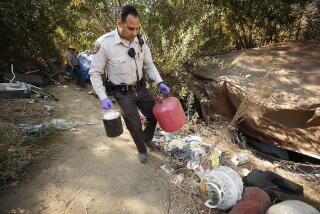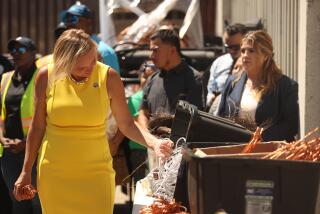Inglewood Council OKs $65,000 Police Study
- Share via
INGLEWOOD — In response to residents’ pleas for more police protection, the City Council has approved spending $65,000 to study the Police Department as a preliminary step toward hiring up to 30 new officers.
To pay for the officers, however, the council indicated that voters would have to approve a special property tax.
The study, which will be conducted by a nonprofit consulting firm, will seek to determine whether current staff members are being used efficiently and how many new officers are needed.
City officials had considered putting a parcel tax on a June ballot to finance the hiring of 30 new officers, but postponed that action and approved the study.
Though police records show that crime has dropped by 25% since 1980 and Inglewood has one of the best residents-to-officer ratios in the South Bay, officials say a growing population and an increasing number of narcotics-related street crimes have created a need for more patrol officers in the 185-member Police Department.
More Protection
Residents frequently appear at council meetings asking for more police protection, and the subject is often discussed by block clubs and neighborhood associations.
The need was highlighted last year when 35 officers from various divisions were placed on an undercover narcotics task force. The task force effort, which lasted from May to November, dramatically reduced street sales in the Dixon-Darby/Lockhaven and Hyde Park neighborhoods. Police made 1,200 arrests.
“The results of the 35-officer drug task force showed what kind of effect several people deployed to work on the same assignment could have in the city,” said Deputy City Manager Norman Norman Cravens.
But it also showed that the department barely has enough officers to undertake a major effort without harming regular patrol, traffic and investigative operations. Some residents in other neighborhoods said they noticed a decrease in police visibility during the undercover effort.
“I understand that they need all the men they can use to get rid of drugs on the other side of town, but I don’t think it is fair that people in the rest of the city should get reduced police protection,” said Gladys Smith, a Morningside Park resident interviewed while the undercover task force was still operating.
Focus of Study
The study is designed to help department administrators juggle special investigation efforts with everyday patrol duties by reviewing the management structure, staff scheduling, use of equipment and use of civilians.
Public Administration Service, the Virginia firm conducting the study, has a history of streamlining police operations by relieving sworn officers from performing low-priority tasks to allow them to spend more time on patrol and investigative duties, Cravens said. The other tasks, such as records and bookkeeping, are transferred to civilian personnel.
The study is scheduled to begin in March and will take about six months to complete, Cravens said.
At that point, the proposed tax will be discussed again, Cravens said. The proposal tabled by the council this week would have charged $90 for a single-family home and $135 for parcels occupied by two, three, and four-unit buildings. Parcels occupied by commercial or industrial facilities or by apartment of condominium buildings with five units or more would have paid $180 annually.
The tax would generate about $2 million a year--enough to finance the salaries, fringe benefits, equipment, vehicles and overtime for 30 additional police officers.
City Manager Paul Eckles, however, advised the council to postpone putting the measure before voters now. “It may be premature,” he said in a memo. “There is no established measure of officers a department serving a city like Inglewood needs.”
The council approved the study in a 4-1 vote with Councilman Virgle Benson opposed.
The Inglewood Police Department has one sworn officer for every 543 people--one of the best coverage ratios in the South Bay. By comparison, neighboring Hawthorne has one officer for every 743 residents and Redondo Beach has one officer for every 625 residents.
More to Read
Sign up for Essential California
The most important California stories and recommendations in your inbox every morning.
You may occasionally receive promotional content from the Los Angeles Times.










